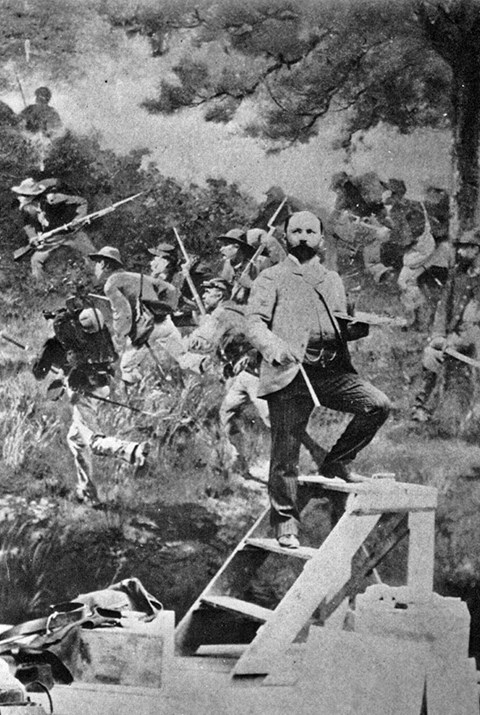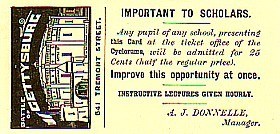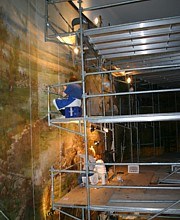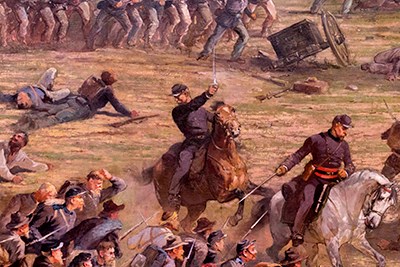
NPS Photo 
Cycloramas were a very popular form of entertainment in the late 1800's, both in America and Europe. These massive, oil-on-canvas paintings were displayed in special auditoriums and enhanced with landscaped foregrounds sometimes featuring trees, grasses, fences and even life-sized figures. The result was a three-dimensional effect that surrounded viewers who stood on a central platform, literally placing them in the center of the great historic scene. Most cycloramas depicted dramatic events such as great battles, religious epics, or scenes from great works of literature. Hundreds were painted and exhibited in Europe and America during the 1800's, yet most were lost or destroyed as their popularity died out with the introduction of a more entertaining art form, motion pictures. The "Battle of Gettysburg" Cyclorama at Gettysburg National Military Park is one that has survived. This fantastic painting brings the fury of the final Confederate assault on July 3, 1863 to life, providing the viewer with a sense of what occurred at the battle long touted as the turning point of the Civil War. The culmination of the battle was captured on canvas by the French artist Paul Philippoteaux, a professional cyclorama painter and artist. Philippoteaux was not present at Gettysburg, but came to the United States in 1879 when he was hired by a group of entrepreneurs to paint this monumental work for a special display in Chicago. Philippoteaux arrived in Gettysburg in 1882 armed with a sketchbook, pencils, pens, and a simple guide book to help him locate the site of the climactic charge. The artist spent several weeks on the battlefield, observing details of the terrain and making hundreds of sketches. To help him recall the landscape with accuracy, Philippoteaux hired a Gettysburg photographer to produce a series of panoramic photographs for his use. These images are some of the earliest detailed photographs of Cemetery Ridge, the Angle and the "High Water Mark", and the field of Pickett's Charge. Philippoteaux was also lucky enough to interview a number of veterans of the battle, who helped with suggestions on how to depict the chaos of battle. Armed with a vast amount of information and ideas, Philippoteaux returned to his studio where he immediately set about laying out the great work. A team of assistants helped him sketch out every detail including soldiers, trees, crops, fences and stone walls, and then began applying tons of oil paint. The phenomenal work took over a year and one-half to complete. The "Cyclorama of the Battle of Gettysburg" opened to the public in Chicago in 1883, complete with a three-dimensional earthen foreground littered with the relics of battle, stone walls, shattered trees and broken fences. Visitors were awed by the painting's spectacular realism. Veterans of the battle, including General John Gibbon whose troops repulsed Pickett's Division on July 3, wrote of its splendor and realism. 
NPS Philippoteaux's "Battle of Gettysburg" received such public acclaim that he was contracted to paint a second version of his monumental work, which opened in Boston in 1884. Once again Philippoteaux's "Battle of Gettysburg" cyclorama received critical acclaim and hundreds of visitors crowded into the specially-built cyclorama building on Tremont Street to view the incredible painting and listen to a lecture on the battle and those personalities involved in this monumental event. The painting was exhibited for nearly twenty years before waning public interest caused the theater to be financially inoperable, and the Gettysburg Cyclorama shut its doors forever. Hearing that the Boston cyclorama was up for sale, a Gettysburg-area entrepreneur purchased the painting and moved it with its props and accoutrements of the foreground, to Gettysburg. The painting arrived in good condition, though several of the panels were ripped and torn and some had rotted around the bottom due to moisture in the soil of the foreground. Repairs were made to the rips by taking portions of the skyline, the upper portion of which was evidently discarded, and stitching them into place where they were painted over by artists as each panel was hung. The cyclorama opened for public exhibition just in time for the 1913 Anniversary celebration of the Battle of Gettysburg, in a specially constructed building on Baltimore Street, and remained there for approximately forty years. Purchased by the National Park Service in the late 1940's, the painting was moved to the newly constructed park visitor center in 1962. The artistic work underwent a massive restoration project that required hours of hand labor to repair water damaged portions of the painting and two large sections faded by years of direct sunlight. The project was completed and the cyclorama re-opened for public viewing in 1962 with the dedication of the National Park Service Visitor Center, which was later titled as the Cyclorama Center. The Gettysburg Cyclorama is 377 feet long, 42 feet high and weighs 12.5 tons. 
Olin Associates-National Park Service Initiated in 2003, the Gettysburg Cyclorama underwent a thirteen million dollar rehabilitation project. Conservation specialists from Olin Associates repaired unstable sections of the canvas and restored original details lost during the numerous repair and preservation attempts on the painting. The cyclorama was moved to the new Gettysburg National Military Park Museum and Visitor Center and placed in its own unique viewing auditorium with a restored skyline and foreground. The conserved painting and restored foreground was unveiled to visitors on September 26, 2008 during the grand opening of the visitor center. The fate of the other Gettysburg Cycloramas has been less fortunate. The Chicago painting was eventually sold and was in private ownership until its donation to Wake Forest University in Winston-Salem, North Carolina. The painting has survived, though it is in desperate need of restoration and a permanent home. Two more versions of the Gettysburg Cyclorama were painted and exhibited, including one shown in Denver, Colorado. One of these was cut up for use as tents by native Americans on a Shoshone Indian Reservation after the turn of the century. The fate of the other painting is unknown. 
Want to see the Cyclorama Painting for yourself? Visit the Gettysburg Foundation website to purchase tickets. |
Last updated: January 23, 2025
